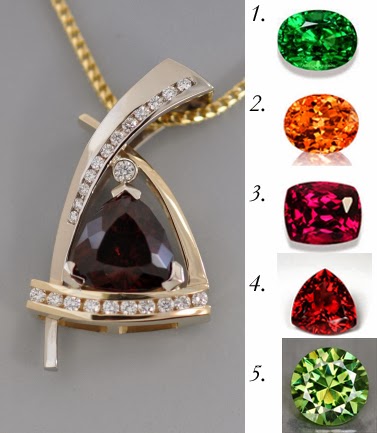Garnet is the birthstone of January.
The name garnet comes from the latin granatum, meaning “seed like,” because of their resemblance to pomegranate seeds. The uses of garnet date back to ancient times. Garnets were popular in ancient Egyptian, Sumerian and Greek and Roman civilizations. It was worn to increase bodily strength and endurance, and strengthen survival instincts during crisis, making it an ideal stone to aid during battle. This stone was held to stimulate blood circulation and keep the circulatory system healthy. Garnet aids in mental ailments as well such as relieving depression and emotional disharmonies; providing protection from unwanted energies and negative behavior patterns.
The stone has a high refraction of light, and was thought to light up the darkness. It is said that Noah used a garnet lantern to help him steer his ark through the dark night. This stone is also said to be one of the twelve stones in the breastplate of the High Priest.
Garnet is also regarded as the friendship stone. In the past, garnets have been exchanged between parting friends to symbolize their affection and to ensure that they meet again.
Although garnet’s most common color is red, it also comes in shades of orange, green and color change. Prices listed below reflect the most common sizes of 2-4 carats in fine quality well cut stones.
Tsavorite (Figure #1) garnet come in either bright, rich or intense green colors. This stone is the most similar to emerald and also one of the most valuable varieties of garnet. The other variety on the list of most valuable garnet variety is color change garnet. The color of this stone can change from a blue or green in daylight , to a reddish or purplish pink color in incandescent light. The only other stone which has such a dramatic color change is alexandrite, one of the most valuable stones. Both tsavorite and color change garnets are priced at $1,000 - $1500 per carat.
Spessartite (Figure #2) garnet come in shades of bright orange to reddish orange. This is a beautiful stone with exceptional brilliance that sometimes rivals in beauty the extremely valuable padparadscha sapphire (to learn more about the padparadscha sapphire, view our September birthstone article). Price of Spessartite ranges in $300-400 per carat. Stones 4 carats or larger, range $400-800 per carat. The more intense the orange, the higher the value.
Hessonite garnet is similar in color to spessartite, but has a brown overtone and costs a fraction. These two stones can be mistaken so you must make sure you are acquiring the stone from a reputable jeweler or gem dealer. Hessonite ranges from $50-80 per carat.
Rhodolite (Figure #3) come in purplish and reddish pink hues. This color is highly attractive to many, also what is attractive about this stone is the price at $80-200 per carat.
Pyrope (Figure #4) is a deep blackish red color. This variety of garnet rarely comes in large sizes; they are usually sold in smaller sizes under 2 carats which range from $80-150 per carat. Larger sizes over 2 carat are up to $300 per carat.
Red garnet is the most common variety. It is a rich red color priced at $30-50 per carat.
Demantoid (Figure #5) is the most valuable variety of garnet. It is a light green color and one of the most brilliant gemstones that exists. Its brilliance and fire is similar to that of a diamond, which is where it got its name. Price of this stone is in the thousands per carat.
Garnet is a fairly durable stone, rating a 7 to 7.5 on the mohs scale, but just like with any other colored stone, should be protected from sharp blows or chemicals.
Pictured is a 6 carat pyrope garnet in 14k gold with diamonds. Designed by Alex Gulko in 2013.
Stop by to view our finest quality garnets for your next design, or see our collection of garnet jewelry.
By Vicky Gulko

No comments:
Post a Comment